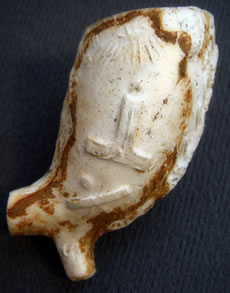Pipe fuels further speculation about links with Freemasonry
An example of an early 19th century clay smoking pipe, bearing beautiful and intricate Masonic symbols, has been uncovered in an archaeological excavation in the gardens of Chiswick House, refuelling speculation about the property’s links with Freemasonry.
The pipe, which was uncovered in one of the 19th century planting beds, is decorated with an acacia leaf, compasses, a set-square, a blazing star surrounded by a sun burst and the ‘All-Seeing Eye’. It was discovered along with a small bone gaming die and glass seal from an early 19th century bottle.
Dave Fellows, an English Heritage archaeologist, said: “It is quite common to find the stems and bowls of smoking pipes dating back to the 19th century, although it is rarer to find a bowl decorated with Masonic symbols.”
Chiswick House was designed by Richard Boyle, the 3rd Earl of Burlington and was completed between 1726 and 1729. The villa provided a beautiful setting for Burlington’s collection of paintings and architectural drawings and he entertained many creative personalities there including Alexander Pope and Handel.
It was an independent architectural historian, Jane Clark, who made the revelation that Lord Burlington was a Freemason, and that Chiswick House’s peculiar design, can be explained by it being a Masonic temple. Those with a taste for mystery and intrigue are fascinated by the Masonic symbols and references in ceiling paintings, in the unusual geometric proportions of the villa and in the blue and red colour scheme.
This find post-dates Burlington’s era by almost a century, and raises the possibility that freemasons did indeed frequent the fascinating gardens at Chiswick House.
Dr D Higgins, an expert in historic pipes, is wary of reading too much into the find, and commented, “We can be certain because of the combination of the production and finishing techniques, as well as the particular arrangement of Masonic motifs, that the pipe dates to between 1800 and 1820. It would have been produced by one of the London makers of the time. Although these pipes must have initially been produced for the Masonic market, we think now that they were probably widely marketed alongside other contemporary designs – so although the find could mean Masons used the gardens at Chiswick it cannot be treated as conclusive proof.”
The Chiswick gardens are of immense historic significance and are claimed as the birthplace of the English landscape garden, widely regarded as one of Britain’s main contributions to European art. Decades of wear and tear and limited funding have taken their toll on the site, prompting the need for a major cash injection to secure its future. To date, £7.9 million has been earmarked by the Heritage Lottery Fund (HLF) as part of a £12.1 million project to restore the gardens. Gifts and pledges have already been secured through a major fundraising campaign, with just £2.million to go to complete the funding needed to restore the park and gardens to their former glory.
April 12, 2007
